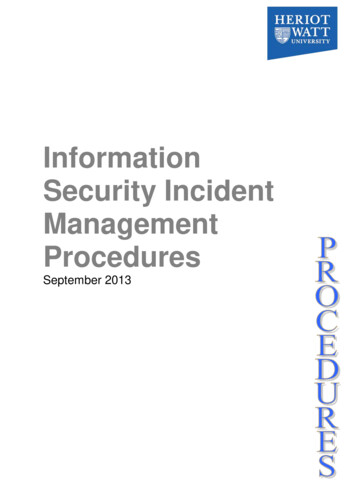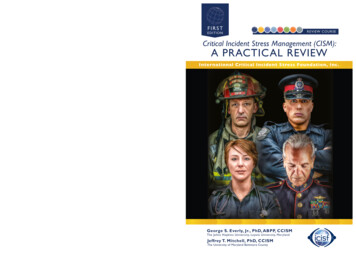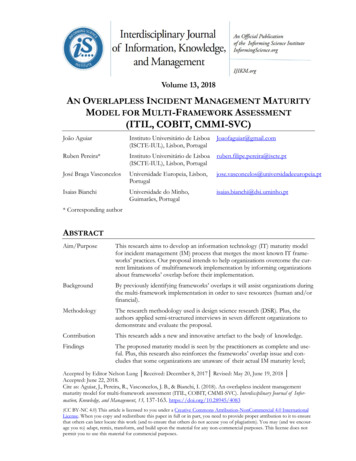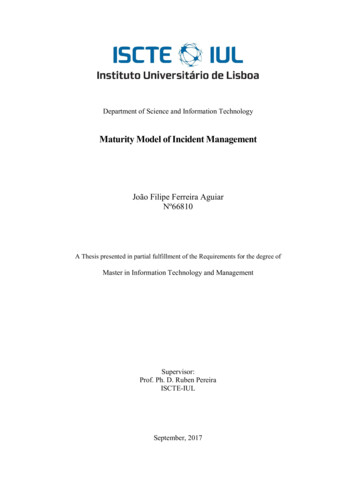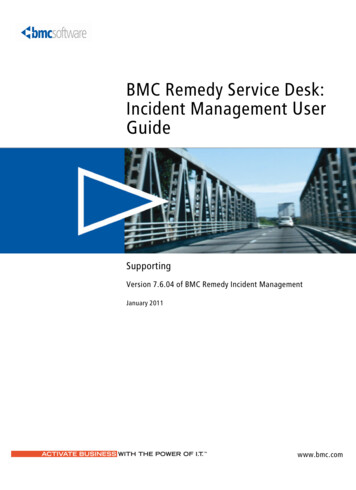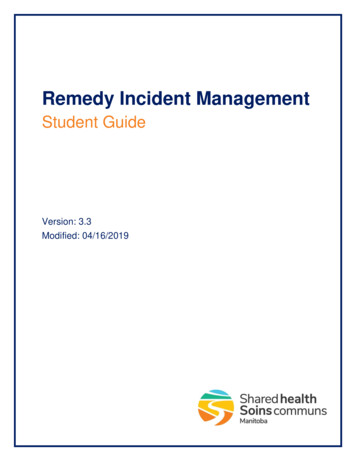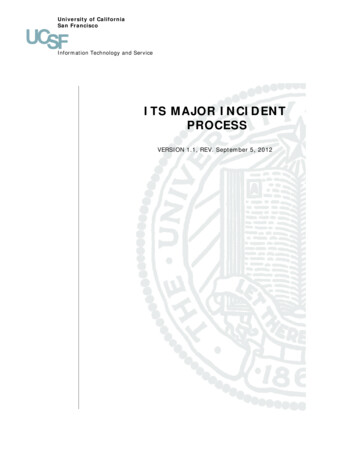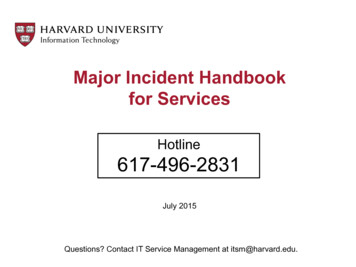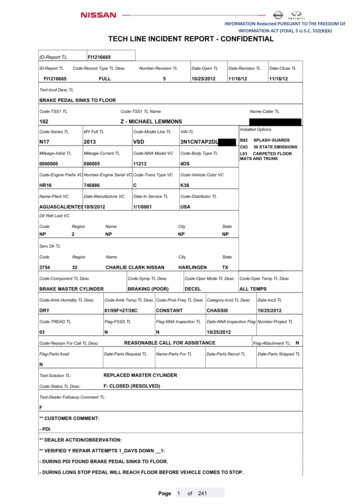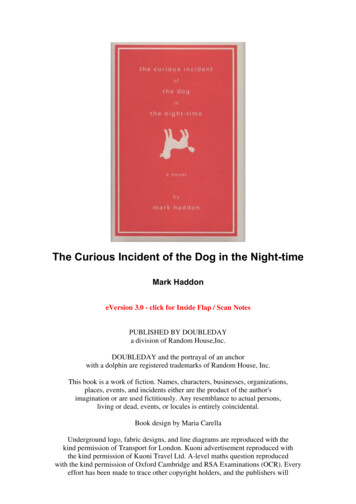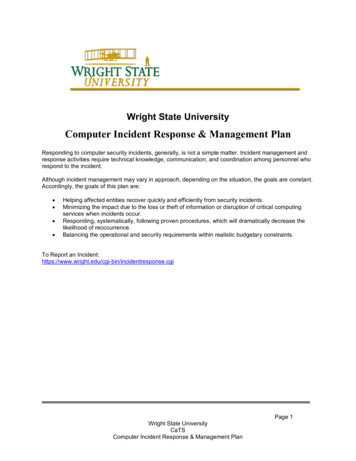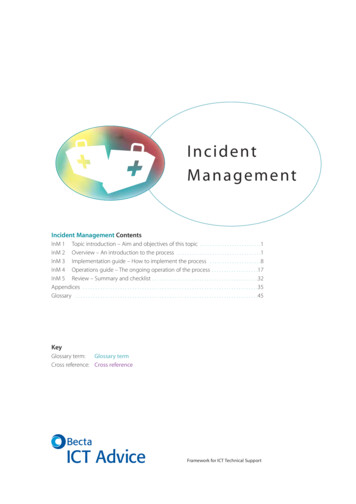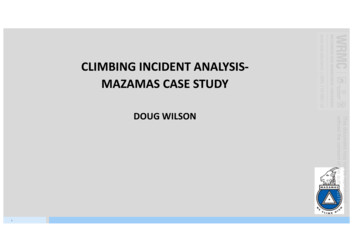
Transcription
CLIMBING INCIDENT ANALYSISMAZAMAS CASE STUDY1This document may not be reproducedwithout the consent of the author 2015DOUG WILSON
MAZAMAS: 1894 todayThis document may not be reproducedwithout the consent of the author 20152
3400 members, 600 volunteers Mission: The Mazamas promotes mountaineering through education,climbing, hiking, fellowship, safety and the protection of mountainenvironments. 250 climbs / year, beginning through advancedClimbing classes, beginning through advanced, youth / adults 900 hikes, backpacks, evening ramblesOutings (domestic and international)Nordic and Ski Mountaineering classes Conservation grants- 18500Research grants- 16000Expedition grantsLocal community youth programsWWW.MAZAMAS.ORGThis document may not be reproducedwithout the consent of the author 2015 3
AGENDA Some background on why and how we developed this analysis 3 Key Learnings Mazama analysis findings and challenges Brainstorming root cause exercise (20 min)4This document may not be reproducedwithout the consent of the author 20151. Identify top 3 -5 incident types2. Brainstorm root causes and factors affecting severity3. Test those causes for commonalities that you will share with yourleaders/participants
Initial Mazama incident reporting system (1999) wasmodeled after Accidents in North AmericanMountaineering Published yearly by American Alpine Club Compilation of first person reports, SAR analysis, and news reportsfor US and CanadaThis document may not be reproducedwithout the consent of the author 20155
ANAM incident types and contributing causesThis document may not be reproducedwithout the consent of the author 2015 We needed toexpand thesetypes and causesspecifically for ourorganization6
We wanted to answer these questions: What are our most frequent climbing incidents? Are this year s incident types similar to previous years? What is the amount of near misses, minor injuries, etc. by incident type? What are the root cause variables that affect each major incident type and arethere any variables that are affecting severity?This document may not be reproducedwithout the consent of the author 2015 Do we need to add any new fields to our incident report and database? What are the commonalities we need to report to our leaders? Specific mountains / routes? Specific education classes with higher incidents? Are our climbing school graduates having more incidents? If so, are we teaching somethingincorrectly? Any indication of leader decision making improvements?7
Mazama Climbing IncidentAnalysis1. ID top incidenttypesDEVELOPMENT2. Brainstorm rootcauses and severityvariablesAdd categories to incidentdatabaseYEARLY UPDATESLeader observations /recommendations fromincident reportsShare commonalitieswith leaders andcome up withsolutions together3. Look forcommonalities withinthose categories8This document may not be reproducedwithout the consent of the author 2015Update incidentsevery year and repeatcommonality analysishas anythingchanged?
KEY LEARNING #1: IDENTIFY YOUR TOP 3 5 INCIDENTS Often done with pie chartsPrefer a horizontal bar chart sorted by highest to lowest # of occurrences (Pareto)Can provide a comparison of current year to previous yearsCan also provide a look at incident categories (near misses, minor injuries, etc.)This document may not be reproducedwithout the consent of the author 20159
MAZAMA CLIMBING INCIDENTS 1998 - 2015Falling rock, ice, or object(s)Fall or slip on snow / ice (following)Lead fall (rock, snow or ice)Fall- other (hiking, scree, etc.)Fall or slip on rock (following)1998-2014Loss of control / glissade2015Rappel Failure / ErrorAnchor failureThis document may not be reproducedwithout the consent of the author 2015OtherCautions Consistent incident definition Sample sizeAvalancheIllness / pre-existing conditionAssisted non-Mazama PartyExceeding abilitiesBehaviorFall into crevasse / moatFaulty use of cramponsLightningWeatherFailure to follow route05101520253035raw # of incidents10
MAZAMA CLIMBING INCIDENTS 1998 - 2015Falling rock, ice, or object(s)Fall or slip on snow / ice (following)Lead fall (rock, snow or ice)Fall- other (hiking, scree, etc.)Fall or slip on rock (following)ASSISTED NON-MAZAMA PARTYLoss of control / glissadeBEHAVIORALRappel Failure / ErrorFATALITYMAJOR INJURYThis document may not be reproducedwithout the consent of the author 2015Anchor failureMINOR INJURYOtherNEAR MISSSEARCH AND RESCUEAvalancheIllness / pre-existing conditionAssisted non-Mazama PartyObservations: minor injuries major injuries- Low near miss reporting- Most of our major injuries occurring with lead fallsExceeding abilitiesBehaviorFall into crevasse / moatFaulty use of cramponsLightningWeatherFailure to follow route05101520253035raw # of incidents11
KEY LEARNING #2 BRAIN STORM ROOT CAUSES / SEVERITYVARIABLES FOR EACH INCIDENT TYPEThis document may not be reproducedwithout the consent of the author 2015 What known causes are there? What other possible issues could have caused the incident? What conditions made the incident worse or better?12
FISHBONE (ISHIKAWA) DIAGRAM EXAMPLE shows the possible causes ofa problem logically arrangedby categoriesThis document may not be reproducedwithout the consent of the author 2015Source: Wikipedia13
FISHBONE DIAGRAM APPLIED TO FALLING OBJECTS (ROCK, ICE, EQUIPMENT)Categories canbecome new fieldsin your databaseThis document may not be reproducedwithout the consent of the author 201514
KEY LEARNING #3 TEST VARIABLES FOR COMMONALITIES Add the new category fields in your database and fill in the data using report narrativesor interview people that submitted the reportMAZAMA PROGRAM (select ONE)ACTIVITYWHAT KIND OF INCIDENT?Pinnacle PeakMt. StuartMt. Washington (OLY)Mt. JeffersonUnicorn PeakMt. HoodMt. JeffersonMultnoma Falls TrailMt. HoodMt. ShuksanMt. HoodBroken TopSahale PeakSahale PeakMt. WashingtonMMCCLIMB- ACLIMB- BCLIMB- BCLIMB- BCLIMB- BCLIMB- CCLIMB- CAYMCLIMB- BCLIMB- CCLIMBING SCHOOL- ASICLIMB- BCLIMB- BCLIMB- BCLIMB- CCLIMBING SCHOOL- ARCLIMBING- ROCKCLIMBING- ROCKCLIMBING- ROCKCLIMBING- ROCKCLIMBING- ROCKCLIMBING- SNOWCLIMBING - ALPINEBACKPACKINGCLIMBING- SNOWCLIMBING - ALPINECLIMBING ICECLIMBING - ALPINECLIMBING - ALPINECLIMBING - ALPINECLIMBING- ALPINECLIMBING- ROCKInjury, illness, or fatalityInjury, illness, or fatalityInjury, illness, or fatalityInjury, illness, or fatalityInjury, illness, or fatalityInjury, illness, or fatalityInjury, illness, or fatalityNear miss or close callInjury, illness, or fatalityNear miss or close callInjury, illness, or fatalityInjury, illness, or fatalityNear miss or close callNear miss or close callInjury, illness, or fatalityInjury, illness, or fatalitySouth RouteCascadian CouloirBig CreekSouth RidgeSnow LakeWest Crater RimSouth Ridgen/aWest Crater RimSulphide Glaciern/aNorthwest RidgeSahale ArmSahale ArmNorth Ridgeclimbing wallSOURCE OF FALLING OBJECTSMazama Party- rockMazama Party- rockMazama Party- rockMazama Party- rockMazama Party- rockNatural- iceMazama Party- rockNatural- rockNatural- iceMazama Party- rockNatural- iceMazama Party- rockMazama Party- rockMazama Party- rockMazama Party- scendingAscendingTERRAIN3rd classscree3rd class3rd classsnow / icesnow / icescreetrailsnow / ice3rd classsnow / icescree5th class4th classscreeMMC WallKNOWN CAUSEknocked down by party memberknocked down by party memberknocked down by party memberknocked down by party memberknocked down by party membernaturalknocked down by party membernaturalnaturalknocked down by party membernaturalknocked down by party memberrope (belay, rappel, team)knocked down by party memberknocked down by party memberfalling equipmentThis document may not be reproducedwithout the consent of the author 2015INCIDENT LOCATION / ROUTE / TRAILMOUNTAIN15
KEY LEARNING #3: FALLING OBJECTS- COMMONALITY ANALYSIS25SOURCE OF FALLING OBJECTS20Clearly our ownparty members arethe root cause ofmost falling rockincidents151025KNOWN CAUSE OF FALLING OBJECTS2015500Natural- iceknocked down byparty memberEquipmentPrimarily on terrain wherethe party is movingtogether un-roped9876rope (belay, rappel, falling equipmentteam)FALLING OBJECTS- ACTIVITYFALLING OBJECTS- TERRAIN10naturalThis document may not be reproducedwithout the consent of the author 2015Natural- rockStart analysis with barcharts for individualcategory fields fromyour fish bone diagram105Mazama Partyrock 51816141210483624120scree3rd class4th class5th classsnow / ice0AscendingDescendingRappellingWaiting16
KEY LEARNING #3: FALLING OBJECTS- COMMONALITY ANALYSIS107Party rock fall- terrain / activityParty rock fall- terrain / unsafe acts968Ascending 3rd, 4th classand scree7654Descending screeNo strong signals forunsafe acts34231210scree0scree3rd classAscending4th classDescendingRappelling5th classWaitingsnow / ice3rd class5th classsnow / ice4th classpoor positionfailed to follow directionsinadequate instructionfailure to test holdsfailure to follow routeunsafe speed (fast/slow)improper procedure / technique Use your expertise to investigate interactions that make sense17This document may not be reproducedwithout the consent of the author 20155
# FALLING OBJECT INCIDENTS / 10000 PERSON-HRS BY MOUNTAINComparisons of sub-groupsof different sizes / totaltime in the field need to benormalized for an apples toapples comparison- e.g.mountain to mountain,climbs vs climbing classesSahale PeakPinnacle PeakMt. Washington (OLY)Mt. ShuksanCastle (Tatoosh)Mt. JeffersonThis document may not be reproducedwithout the consent of the author 2015Broken TopNorth SisterMt. WashingtonMt. ThielsenMt. OlympusMt. StuartMt. HoodMt. AdamsMiddle SisterUnicorn Peak012345618
SHARING WITH LEADERSFINDINGS Rock fall is the #1 climbing incident 77% of rock fall incidents are caused by Mazama party members themselves 38% occur on scree (primarily descending), 42% on 3 rd / 4th class (primarily ascending) Occurs on B and C climbs with moderate to experienced party members No clear contributing causes- 33% are party members not following leader directions, and 25% are partymembers not paying attention to their positionThis document may not be reproducedwithout the consent of the author 2015RECOMMENDATIONS Ascend / descend narrow gullies and scree 2-3 climbers at a time rather than as a group and use islands of safetyfor group members below to wait outside the fall line Spread out parallel when ascending / descending wide scree fields Leaders need to constantly remind team members of potential high rock fall areas Individual team members have to have situational awareness of their surroundings- are there people abovethem or below them? Add specific rock fall discussions in both BCEP and ICS curricula19
This document may not be reproducedwithout the consent of the author 201520
FALLS ON SNOW- COMMONALITY ANALYSISEQUIPMENT- CRAMPONSEQUIPMENT- ICE AXE1220181016148126108464220ice axeno cramponsski polesEQUIPMENT- ROPED / UN-ROPED20This document may not be reproducedwithout the consent of the author 20150cramponsSNOW CONDITIONS1018Roped injury vs un-ropedinjury (roped near missesnot nesoftneveicyglacial ice21
FALLS ON SNOW- COMMONALITY ANALYSISFALLS ON SNOW- EQUIPMENT/SNOW CONDITIONSLeader discussions- weighing party memberexperience and the potential / severity of a fallvs time saved when deciding to rope up and /or wear crampons109876This document may not be reproducedwithout the consent of the author 2015543210softcrampons - unropednevecrampons - ropedicycrampons - handlineglacial iceno crampons - unroped22
Summary of Mazama learningsWHAT WE FOUND77% of incidents caused by Mazama party members onscree / scrambling terrainWHAT WE DIDInvolved climb leaders to rethink group managementin rock fall environmentsFalls on snowprimarily un-roped and/or w/o cramponsLeader discussions- weighing party member experienceand the potential / severity of a fall vs time savedwhen deciding to rope up and / or wear crampons .Lead fallsIntermediate Sport climbing class 8x higher than actualclimbsSafety review of class- rock gym to outside trainingFalls on rockPrimarily un-roped, 50% were failure to test holdsLeader discussions- weighing party member experienceand the potential and severity of a fall vs time savedwhen deciding to rope up on 3rd / 4th class terrain.Lack of near miss reportingNear misses 15% incidents of total reportedleader education of the importance of near missreportingThis document may not be reproducedwithout the consent of the author 2015INCIDENT / PROBLEMFalling objects (rock)Challenges / To Do getting leaders to file reports trending results with a small data set to see if fixes are working customize online incident report by type?23
SUMMARY: 3 KEY LEARNINGS24This document may not be reproducedwithout the consent of the author 20151. Identify top 3 -5 incident types Use a consistent incident definition and adjust reports if necessary Sample size2. Brainstorm root causes and factors affecting severity3. Test those causes for commonalities. Share findings and work with your leaders/participants to reducefuture occurrences
BRAINSTORMING EXERCISE (20 min)This document may not be reproducedwithout the consent of the author 2015 Pick an incident type from your organization that youwant to understand root causes Work by yourself or with others Identify your known causes Brain storm other possible causes Generate a fishbone diagram25
Mt. Washington (OLY) Big Creek CLIMB- B CLIMBING- ROCK Injury, illness, or fatality Mazama Party- rock Ascending 3rd class knocked down by party member Mt. Jefferson South Ridge CLIMB- B CLIMBING- ROCK Injury, illness, or fatality Mazama Party- rock
